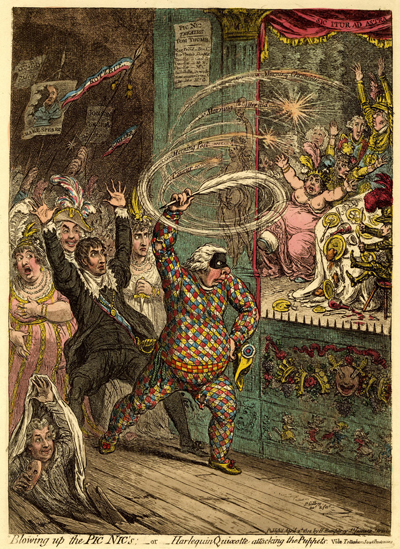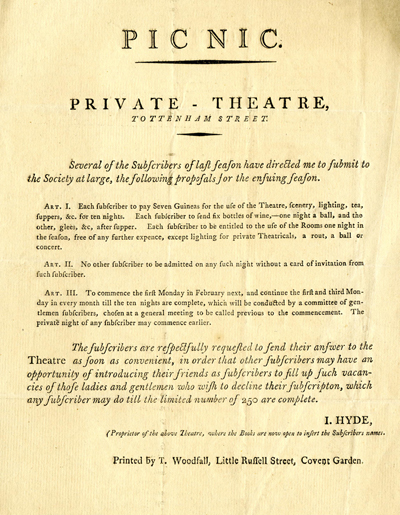Blowing up the Pic Nic's, or Harlequin Quixotte attacking the Puppets.
This is the first of three prints relating to the war of words that broke out in the newspapers of the fashionable London world in 1802 over the threat posed to the patent theaters (e.g. Covent Garden and Drury Lane) by the plans of a theater to be established in Tottenham Street by the Pic Nic Society.

© Trustees of the British Museum
Unlike the private theatricals at Blenheim, Richmond, or Brandenburgh House, which were part of a long-standing English tradition, the Pic Nic Theatre was not part of a family house or estate, but an approximately 300 seat city location, formerly devoted to concerts, which was being purposely altered to present theatricals. The pool of performers was not just a small group of family members or neighbors, but included, in some cases, lesser known professionals, resulting in a heterogeneous mixture of talent and class. After the performances, there was also food and cards. But perhaps most importantly, performances were funded by subscription rather than being free to a specifically invited set of people.

© Trustees of the British Museum
The managers of the Theatres Royal at Drury Lane and Covent Garden saw this as an infringement on their patents as sole purveyors of "serious" theatre and, more importantly, a potential drain upon their revenue stream, since support for the Pic Nics came from the very class of people most likely to patronize the professional theatres. They also pretended to see it as a threat to morality.
Pic Nic proponents,on the other hand, saw the opposition from the regular theatres as a petty over-reaction to their fairly modest plans, but a potentially significant abridgment of their rights and freedoms as citizens. Naturally, both claimed to have legal justification on their side.
In Blowing up the Pic Nic's, the theatrical establishment is led by the portly Richard Brinsley Sheridan, playwright and owner of the Theatre Royal, Drury Lane, dressed as a mischievous Harlequin with a now empty money-bag at his belt. Behind him are the famous opera star Mrs. Billington portrayed as she appeared in Gillray's earlier print, A Bravura Air. Mandane (1801); the tragic actor, John Philip Kemble in his role as Hamlet; and his sister, Sarah Siddons, with a dagger as in Gillray's print Melpomene (1784). Just behind them is the mainly comic actor William Thomas Lewis, theatre manager of the other patented venue, the Theatre Royal, Covent Garden. And on the far left foreground, emerging from the stage floor, we see the famous actor/manager David Garrick come back to life to support the cause of the professionals.
On their side, the Pic Nics are represented by the conspicuously bare-breasted Lady Buckinghamshire, playing (according to the list of Dramatis Personae posted next to the puppet stage) Queen Dollallolla from Henry Fielding's parody, The Tragedy of Tom Thumb. Behind her in profile is Lady Salisbury playing Princess Huncamunca. And behind her are Colonel Greville (in military uniform) playing Mr. Noodle a courtier, and the towering Lord Cholmondeley as King Arthur. As the name of the Society suggests, the meetings of the Pic Nics always included food and drink provided by its members and assigned in advance by drawing lots. So the diminutive Lord Mount Edgecumbe who plays the lead role of the similarly tiny Tom Thumb is shown with dinner disrupted and knife and fork still in hand.
As early as March 2, 1802, the Morning Post was portraying the dispute between the two sides as a kind of war. So it is not surporising that Gillray would have picked up on the image in his print.
It has been thought by some hard, while the proprietors of Drury-lanc Theatre have been engaged in the field of Chancery, in a long combat with a host of lawyers, bankers, and builders, that just as victory [was] declared on their side, and an amicable settlement . . . announced, they should be attacked on the flank by General Pic-Nic [probably Colonel Greville, the major spokesman for the group].
But in spite of this account's assertion that "Field.Marshal SHERIDAN . . .does not mean himself to take the field against him [General Pic Nic], but leaves the command to that distinguished Chief of Brigade, General Sir RICHARD FORD" (a Bow Street Magistrate), Gillray is almost certainly correct in depicting the explosive attacks on the Pic Nics in newspapers such as the Courier, Morning Post, Morning Herald and the Morning Chronicle as emanating from the skilled pen of Sheridan himself.
Here, for instance, is a letter from a (conveniently anonymous) correspondent in the February 26, 1802 edition of the Morning Chronicle purporting to explain "the words Pic-Nic used to characterise the intended suppers at the new Theatrical Institution." It's hard to resist the suspicion that the "correspondent" is the witty playwright and seasoned orator Sheridan.
As to the first syllable of the word, Pic, it comes from pickle; which Dr. Johnson in his Dictionary informs us, means not only salt liquor to preserve flesh, or any thing so preserved; but also, 'A pickled Rogue, consummately villainous; seasoned, and imbued highly with every thing bad.' Again, as to the meaning of the word Nic. I will say nothing of an aged Personage to whom this appellation is most generally applied; but the Learned Dr. Johnson gives, as one of its significations, 'to cozen at Dice or Cards.' So that I presume that by a Pic-Nic Supper, must be intended an Entertainment 'consummately villainous, seasoned, and imbued highly with every thing bad; and where the object is to cozen at Dice or Cards.'
The depth of feeling aroused by the controversy on both sides may be suggested by the fact that on the first announced Pic Nic performance, according to the March 15 edition of the London Star, "a drill serjeant and about half a dozen rank and file" from the Marlborough-Street Police Office were posted in the hall and at the door of the theatre in case of a riot.
Not surprisingly for an equal-opportunity satirist, Gillray launches attacks upon both sides. One object of Gillray's satire is, of course, the Pic Nics themselves. The nude muse of comedy who appears on the pilaster next to the stage taking an obvious delight in exposing her bottom coupled with the obviously bare-breasted Lady Buckinghamshire at stage center both seem to confirm a suspicion of loose aristocratic morals that was associated with the Pic Nics. This charge was later explored and confirmed in Gillray's Dilettanti Theatricals (February 18, 2003).
But if the Pic Nics are guilty of loose morals, the Professional actors are hardly innocent, seeming to harbor potentially revolutionary pro-French sentiments. Although they still carry the tattered banners of native English playwrights including Shakespeare, Otway, Rowe, Jonson, and Congreve, they now seem to favor the more prominent tri-colour banners of pro-French authors like Kotzebue and Schiller.
Gillray's principal charge against the professional actors, however, is that they are over-reacting to what is really a minor threat. Sheridan and the professional actors are the only ones armed and shown full scale. The Pic Nics, on the other hand, are but "puppets" on a miniature stage. In this sense, the attack is a quixotic quest against a largely imaginary opponent. It is probably no accident that the play the Pic Nics are performing is Tom Thumb whose hero is himself a miniature.
Sources and Reading
- Commentary from the British Museum on Blowing up the Pic Nic's.
- Janine Marie Haugen, The Mimic Stage: Private Theatricals in Georgian Britain
- "The History of the Picnic," History Today
- "Harlequin," Wikipedia
- "Elizabeth Billington," Wikipedia
- "George Cholmondeley, 1st Marquess of Cholmondeley," Wikipedia
- "Richard Edgcumbe, 2nd Earl of Mount Edgcumbe," Wikipedia
- "David Garrick," Wikipedia
- "Henry Francis Greville," Wikipedia
- "Albinia Hobart," Wikipedia
- "John Philip Kemble," Wikipedia
- "William Thomas Lewis," Wikipedia
- "An Unconventional Marchioness: The Life of Lady Salisbury," All Things Georgian
- "Richard Brinsley Sheridan," Wikipedia
- "Sarah Siddons," Wikipedia
- Thomas Wright and R.H. Evans, Historical and Descriptive Account of the Caricatures of James Gillray #516.
- Thomas Wright and Joseph Grego, The Works of James Gillray, the Caricaturist; With the History of His Life and Times, p. 288.
Comments & Corrections
NOTE: Comments and/or corrections are always appreciated. To make that easier, I have included a form below that you can use. I promise never to share any of the info provided without your express permission.